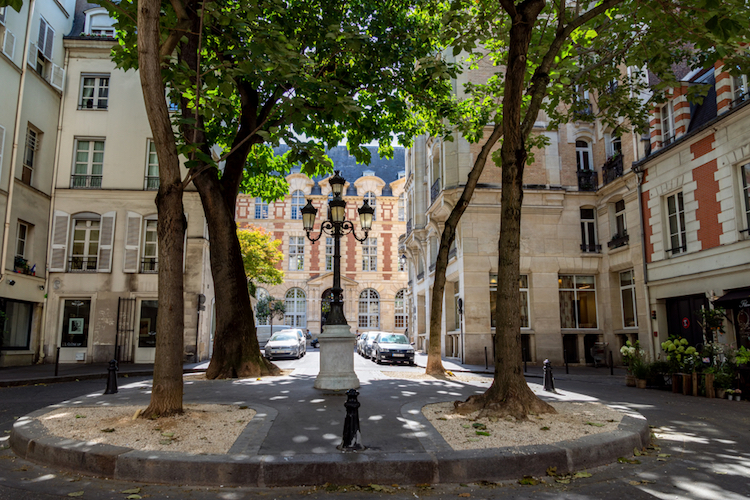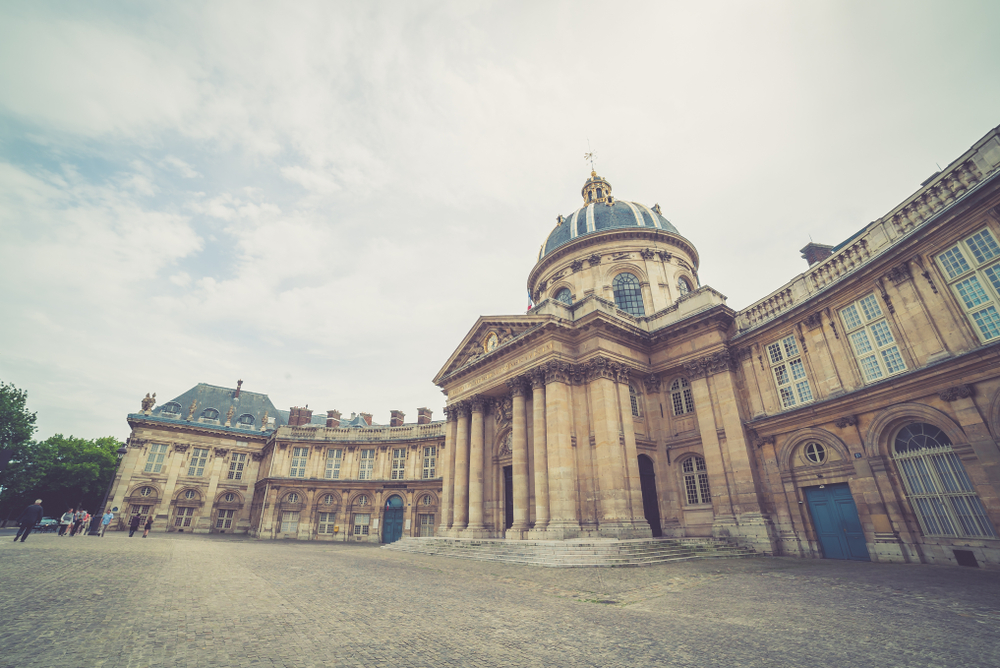Editor’s Note: Paris real estate expert and Haute Residence partner KC Martin gives you a guide to some of the most beautiful places in the City of Lights to visit outside of the Eiffel Tower.
Paris’ spectacular Eiffel Tower is breathtaking, especially for anyone viewing it for the first time from the Trocadero. Yet, Paris offers a plethora of exquisite things and places. This is my list of the top 8 other incredibly beautiful places to visit while you’re in Paris!
1 – Palace de la Concorde (Concorde Square) – A grand square in the 8th arrondissement of Paris, 75008
 Photo Credit: Shutterstock
Photo Credit: Shutterstock
Built in 1772, it is the largest square of Paris. Until 1830, the square was renamed several times before finally being named ‘Place de la Concorde’. It is surrounded by Paris’ most distinguished hotels and is located next to Tuilerie Gardens and the Champs-Élysées. Next to the square you can find the Orangerie and the Jeu de Paume museums. There is a large Egyptian obelisk standing at the center of the Concorde Square which is called ‘Luxor Obelisk’. It is the oldest monument in Paris.
2 – Place de Furstemberg – A small picturesque square behind the Germain-des-Pres-church in the 6th arrondissement of Paris, 75006
 Photo Credit: Shutterstock
Photo Credit: Shutterstock
Noted as one of the most picturesque squares in Paris, Place de Furstemberg, can be found in the heart of the affluent 6th arrondissement, tucked in among the web of streets found between Boulevard Saint-Germain and the left bank of the Seine. The “place” is actually a road, but the surrounding buildings are placed around the central island and form a kind of courtyard, hence its title. The Haussmannian architecture that defines Paris is particularly noticeable both here and in the surrounding roads. This is authentic Paris.
Place de Furstemberg along the Rue de Furstenberg sits in what used to be the first Saint-Germain-des-Pres Abbey built in the 6th century by Childebert I. It remains a picture-perfect artistic and intellectual corner in old Paris, quiet and beautiful with pretty trees in the center, like a masterpiece painting.
Home to the Delacroix Museum, his home and studio, this little square is so romantic and makes your heart beat a little faster when you’re there. A fantastic, quiet place to get engaged! And, for Harry Potter fans, The French Ministry of Magic Headquarters, concealed underground, can be accessed through a “magical entrance” at Wallace fountain at Place de Furstemberg.
3- Pont Alexandre III – Quai d’Orsay in the 8th arrondissement of Paris, 75008
 Photo Credit: Shutterstock
Photo Credit: Shutterstock
A decked arch bridge which crosses the Seine river in Paris. It connects the Champs-Elysees quarter with those of the Invalides and Eiffel Tower. The bridge is widely regarded as the most ornate, extravagant bridge in Paris, and is classified as a French historic monument. It is perfect for viewing vistas of Paris from above the Seine, and for romantic evening walks. A functional bridge which doubles as a magnificent work of art, perfectly French.
The bridge was built between 1896 and 1900 in a Beaux-Arts style with its embellished Art Nouveau lamps, nymphs, cherubs, and winged horses at either end. It is named after Tsar Alexander III who had concluded the Franco-Russian Alliance in 1892. His son, Nicolas II of Russia, laid its foundation stone in October 1896. The style of the bridge reflects that of the Grand Palais to which it leads on the right bank.
4- The Institut de France is the seat of the Académie Francaise – French Academy in the 6th arrondissement of Paris, 75006
 Photo Credit: Shutterstock
Photo Credit: Shutterstock
The Institut de France – Academie Francaise is located by the Pont des Arts, the footbridge that connects it to the Louvre Palace. The building originally accommodated the Collège des Quatre Nations. Its construction, funded with the legacy left by Cardinal Mazarin lasted from 1662 and 1680.
The Collège des Quatre Nations opened in 1688. It provided tuition to 60 young noblemen from Piedmont, Alsace, Artois and Flanders for the following 101 years.
The Institut de France was founded in 1795, but sat in the Louvre until 1805, when Napoleon transferred it to the former Collège des Quatre Nations.
La Coupole, as it is commonly called, is a true feat of architecture. Le Vau indeed succeeded in creating a dome circular on the outside and oval on the inside! This building, housing the rooms of the ordinary sessions of the academies, was classified historical monument in 1862.
The Institut de France regroups the Académie Française founded by Richelieu in 1635, the Académie des Inscriptions des Belles Lettres (Literature) and the Académie des Sciences founded by Colbert respectively in 1663 and 1666. It also includes the Académie des Beaux-Arts (Fine Arts) founded in 1816, and the Académie des Sciences Morales et Politiques (Moral and Political Sciences) founded in 1832.
The French Academy is a prestigious French academic foundation. It has been composed of 40 members Académiciens since 1980. The Institute manages approximately 1,000 foundations and museums and chateaux. The Académiciens are elected by a college of their peers and approved by the President of the French Republic, their patron.
The Immortels, as they are known, are in charge of various missions. One of them is to protect and ensure the proper use and evolution of French language and contribute to the addition of new words in the dictionary. This definitely qualifies as an inspirational place to visit.
5- Jardin du Luxembourg (Luxembourg Gardens) – in the 6th arrondissement of Paris, 75006
 Photo Credit: Shutterstock
Photo Credit: Shutterstock
The Jardin du Luxembourg was created beginning in 1612 by Queen Marie de’ Medici, the widow of King Henry IV of France, for a new residence she constructed, the Luxembourg Palace. The garden is owned today by the French Senate, which meets in the Palace. It covers 23 hectares and is known for its lawns, tree-lined promenades, flowerbeds, model sailboats on its circular basin, and the incredibly picturesque Medici Fountain, built in 1620. The name Luxembourg comes from the Latin Mons Lucotitius, the name of the hill where the garden is located. Spectacular, in absolutely every season in a different way, the gardens are elaborate and would need many images to show the full incredible breadth of their presence.
6 – Palais de la Légion d’Honneur – in the 7th arrondissement of Paris, 75007
 Photo Credit: Shutterstock
Photo Credit: Shutterstock
The Palace of the Legion of Honour is a historic building on the Left Bank of the River Seine. It houses the Musée de la Légion d’honneur (‘Museum of the Legion of Honour’) and is the seat of the Legion d’ Honneur, the highest French order of merit. The building is also known as the Hotel de Salm. It is located at 64 rue de Lille, next to the Musée d’Orsay.
The museum is housed within the Hôtel de Salm, built in 1782 by architect Pierre Rousseau for Frederick III, Prince of Salm-Kyrburg. The building burned in 1871 during the Paris Commune, and it subsequently was restored by a subscription of medallists. Since 1804, this building has been called the Palais de la Legion d’Honneur and it is the seat of France’s highest honours: the Legion d’Honneur (1802), the Medaille militaire (1852), and the Ordre national du Merite (1963).
Today’s museum was created in 1925. It displays a history of France’s honours, medals, decorations, and chivalric orders from the time of King Louis XI to the present, including Napoleonic souvenirs and more than 300 portraits. A special section is dedicated to foreign orders. Its library and archives contain more than 3,000 works.
7 – Palais Garnier – L’Opera national de Paris – Place de l’Opera in the 9th arrondissement of Paris, 75009
 Photo Credit: Shutterstock
Photo Credit: Shutterstock
If you can’t visit Versailles while in France, the Palais Garnier will take your breath away! Its ornate interior with gold gilding and crystal, layered with elaborate frescos and paintings will transport you to somewhere else enchanting. Plan to visit the Palais Garnier/Opéra Garnier for its acclaimed opera and ballet.
In the tradition of Italian theatre, the horseshoe-shaped “French” auditorium, so-called for the way the seats are arranged according to their category, was designed for the audience to see and to be seen. Its metallic structure, hidden by marble, stucco, velvet and gilding, supports the weight of the 8-ton bronze and crystal chandelier with its 340 lights. The house curtain was created by theatrical painters Auguste Rube (1817-1899) and Philippe Chaperon (1823-1906), following Charles Garnier’s instructions. The ceiling painted by the famous Marc Chagall and commissioned by the Minister of Culture André Malraux was inaugurated on September 23, 1964.
At the end of a long gallery is the Rotunde du Glacier, a fresh and bright rotunda with a ceiling painted by Clairin (1843-1919) and featuring dancing bacchantes and fauna, along with tapestries illustrating different refreshments as well as fishing and hunting. Completed after the opening of the Palais Garnier, this salon evokes the aesthetic of the Belle Époque.
The vault of the Avant-Foyer is covered with mosaics of shimmering colours on a gold background. The view of the Grand Staircase is spectacular. The play of light between mirrors and windows in the Grand Foyer further accentuates the latter’s vast dimensions. The ceiling painted by Paul Baudry (1828-1886) features themes from the history of music.
Each year, the Paris Opera presents about 380 performances of opera, ballet, and other concerts to an audience of 800,000 people, many of whom travel from abroad at almost 100% capacity seating. Truly astounding.
8 -Place du Tertre, Montmartre in the 18th arrondissement of Paris, 75018 Photo Credit: Shutterstock
Photo Credit: Shutterstock
This square in Montmartre which means “little hill”, was once frequented by many of Paris’ greatest artists. Today, it is still and art haven for professional and amateur artists alike. It is located only a few streets away from Montmartre’s Basilica of the Sacre Coeur, near the summit of Paris’ elevated Montmartre quarter. The Place du Tertre was the heart of the prestigious Benedictine Montmartre Abbey, established in 1133 by King Louis VI.
The Montmartre Abbey thrived through the centuries until the French revolution under the patronage of the Kings of France. Place du Tertre was opened to the public in 1635 as Montmartre village central square. From the end of the 18th century until World War I, the whole Montmartre Boheme could been seen here: painters, songwriters and poets.
At the beginning of the 20th century, many painters including Pablo Picasso and Amedeo Modigliani were living here. The Musee de Montmartre, the former home and studio of Pierre-Augusto Renoir and the L’Espace Salvador Dalí, a museum principally dedicated to the sculpture and drawings of Salvador Dali, can be found near Place du Tertre.
With many artists setting up their easels here each day for painting, the Place du Tertre is a reminder of the time when Montmartre was the center in Paris for modern art.
There are many restaurants here and you can have your portrait done by one of the many artists at the square. It is like going back in time to the era of Picasso and Dali. The Dali museum is around the corner. This area absolutely makes you feel like you’re in the movie “Mignight in Paris”.
Quick tip: there is an elevator on the left side of the giant stairs to Montmartre, if the stairs seem too daunting. At the top of the Sacre Coeur is a wondrous panoramic view of Paris.




